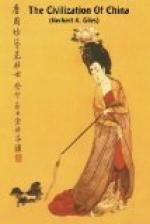Just as in poetry, so in pictorial art, the artist avoids giving full expression to his theme, and leaving nothing for the spectator to supply by his own imaginative powers. “Suggestion” is the key-note to both the above arts; and in both, “Impressionism” has been also at the command of the gifted, centuries before the term had passed into the English language.
Literature and art are indeed very closely associated in China. Every literary man is supposed to be more or less a painter, or a musician of sorts; failing personal skill, it would go without saying that he was a critic, or at the lowest a lover, of one or the other art, or of both. All Chinese men, women and children seem to love flowers; and the poetry which has gathered around the blossoms of plum and almond alone would form a not inconsiderable library of itself. Yet a European bouquet would appear to a man of culture as little short of a monstrosity; for to enjoy flowers, a Chinaman must see only a single spray at a time. The poorly paid clerk will bring with him to his office in the morning some trifling bud, which he will stick into a tiny vase of water, and place beside him on his desk. The owner of what may be a whole gallery of pictures will invite you to tea, followed by an inspection of his treasures; but on the same afternoon he will only produce perhaps a single specimen, and scout the idea that any one could call for more. If a long landscape, it will be gradually unwound from its roller, and a portion at a time will be submitted for the enjoyment and criticism of his visitors; if a religious or historical picture, or a picture of birds or flowers, of which the whole effort must be viewed in its completeness, it will be studied in various senses, during the intervals between a chat and a cup of tea. Such concentration is absolutely essential, in the eyes of the Chinese critic, to a true interpretation of the artist’s meaning, and to a just appreciation of his success.
The marvellous old stories of grapes painted by Zeuxis of ancient Greece, so naturally that birds came to peck at them; and of the curtain painted by Parrhasius which Zeuxis himself tried to pull aside; and of the horse by Apelles at which another horse neighed—all these find their counterparts in the literature of Chinese art. One painter, in quite early days, painted a perch and hung it over a river bank, when there was immediately a rush of otters to secure it. Another painted the creases on cotton clothes so exactly that the clothes looked as if they had just come from the wash. Another produced pictures of cats which would keep a place free from rats. All these efforts were capped by those of another artist, whose picture of the North Wind made people feel cold, while his picture of the South Wind made people feel hot. Such exaggerations are not altogether without their value; they suggest that Chinese art must have reached a high level, and this has recently been shown to be nothing more than the truth, by the splendid exhibition of Chinese pictures recently on view in the British Museum.




